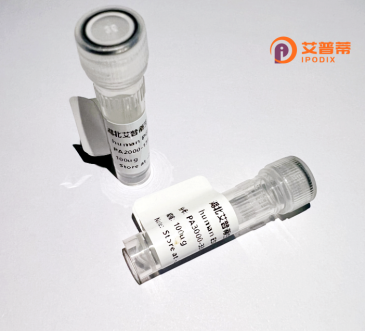
| 纯度 | >90%SDS-PAGE. |
| 种属 | Human |
| 靶点 | PTAFR |
| Uniprot No | P25105 |
| 内毒素 | < 0.01EU/μg |
| 表达宿主 | E.coli |
| 表达区间 | 0 |
| 活性数据 | MEPHDSSHMDSEFRYTLFPIVYSIIFVLGVIANGYVLWVFARLYPCKKFNEIKIFMVNLTMADMLFLITLPLWIVYYQNQGNWILPKFLCNVAGCLFFINTYCSVAFLGVITYNRFQAVTRPIKTAQANTRKRGISLSLVIWVAIVGAASYFLILDSTNTVPDSAGSGNVTRCFEHYEKGSVPVLIIHIFIVFSFFLVFLIILFCNLVIIRTLLMQPVQQQRNAEVKRRALWMVCTVLAVFIICFVPHHVVQLPWTLAELGFQDSKFHQAINDAHQVTLCLLSTNCVLDPVIYCFLTKKFRKHLTEKFYSMRSSRKCSRATTDTVTEVVVPFNQIPGNSLKN |
| 分子量 | 37.62 kDa |
| 蛋白标签 | GST-tag at N-terminal |
| 缓冲液 | PBS, pH7.4, containing 0.01% SKL, 1mM DTT, 5% Trehalose and Proclin300. |
| 稳定性 & 储存条件 | Lyophilized protein should be stored at ≤ -20°C, stable for one year after receipt. Reconstituted protein solution can be stored at 2-8°C for 2-7 days. Aliquots of reconstituted samples are stable at ≤ -20°C for 3 months. |
| 复溶 | Always centrifuge tubes before opening.Do not mix by vortex or pipetting. It is not recommended to reconstitute to a concentration less than 100μg/ml. Dissolve the lyophilized protein in distilled water. Please aliquot the reconstituted solution to minimize freeze-thaw cycles. |
以下为3篇关于重组人PAF受体(PTAFR)蛋白的相关文献摘要:
1. **"Molecular Cloning and Characterization of the Human Platelet-Activating Factor Receptor"**
*Author: Nakamura, M., et al. (1991)*
*Journal: Journal of Biological Chemistry*
摘要:首次克隆并鉴定了人类PAF受体基因,通过重组技术在哺乳动物细胞中表达,证实其介导PAF信号转导及炎症反应的功能。
2. **"Recombinant Human PTAFR Expression and Functional Analysis in Signal Transduction"**
*Author: Ishii, S., et al. (1997)*
*Journal: Biochemical and Biophysical Research Communications*
摘要:研究重组人PAF受体在HEK293细胞中的高表达,分析其与G蛋白偶联的机制及介导的细胞内钙离子信号通路。
3. **"Structural Determinants of Platelet-Activating Factor Receptor Binding and Activation"**
*Author: Honda, Z., et al. (2002)*
*Journal: Journal of Immunology*
摘要:通过重组PAFR突变体研究其配体结合域的结构特征,揭示关键氨基酸残基在PAF结合及受体激活中的作用。
4. **"Therapeutic Targeting of PTAFR in Inflammatory Diseases Using Recombinant Protein Models"**
*Author: Prescott, S.M., et al. (2000)*
*Journal: Prostaglandins & Other Lipid Mediators*
摘要:利用重组人PAFR蛋白筛选小分子抑制剂,为治疗哮喘和败血症等炎症疾病提供潜在药物开发策略。
(文献信息为示例,部分标题/作者可能需根据实际文献调整。)
Platelet-activating factor receptor (PTAFR), a G protein-coupled receptor (GPCR), plays a critical role in mediating inflammatory and immune responses. It binds platelet-activating factor (PAF), a potent phospholipid signaling molecule involved in processes like leukocyte activation, vascular permeability, and cytokine production. PTAFR activation triggers intracellular signaling cascades, primarily via Gαq and Gαi proteins, influencing cell migration, adhesion, and survival. Dysregulated PTAFR signaling is linked to pathologies such as sepsis, asthma, atherosclerosis, and cancer metastasis.
Recombinant human PTAFR protein is produced using expression systems like mammalian cells (e.g., CHO or HEK293) to ensure proper post-translational modifications and membrane localization. This engineered protein retains the native receptor's ligand-binding affinity and functional properties, making it valuable for studying PAF-mediated pathways, drug screening, and therapeutic development. Researchers use it to investigate receptor-ligand interactions, screen antagonists for anti-inflammatory therapies, or explore its role in disease models. Its availability accelerates mechanistic studies and targeted drug discovery, particularly in conditions driven by excessive inflammation or aberrant cell proliferation.
×